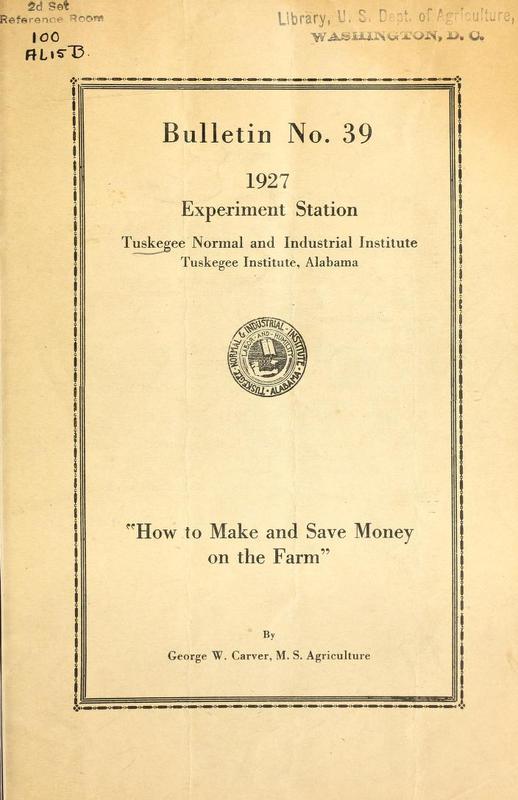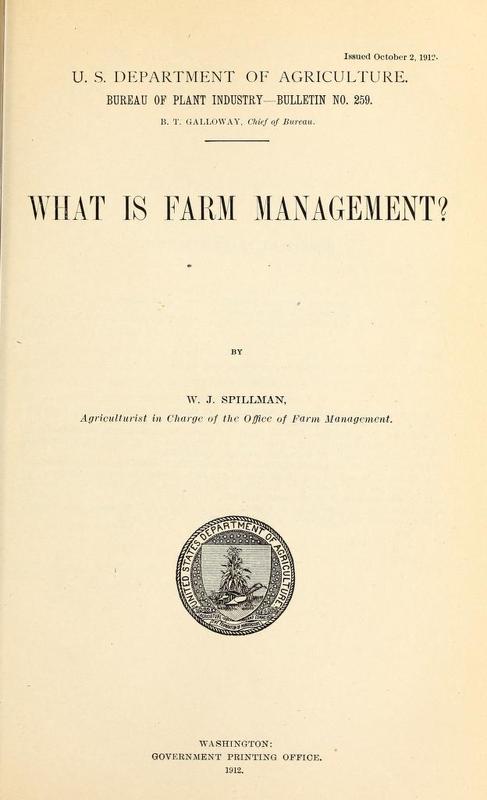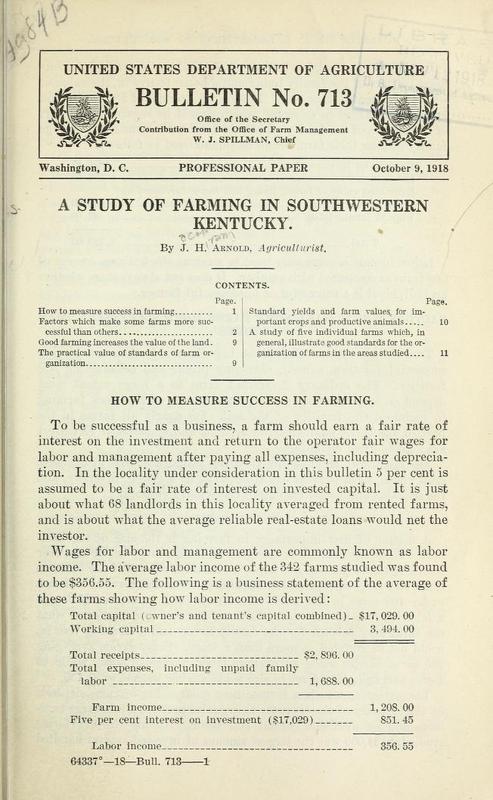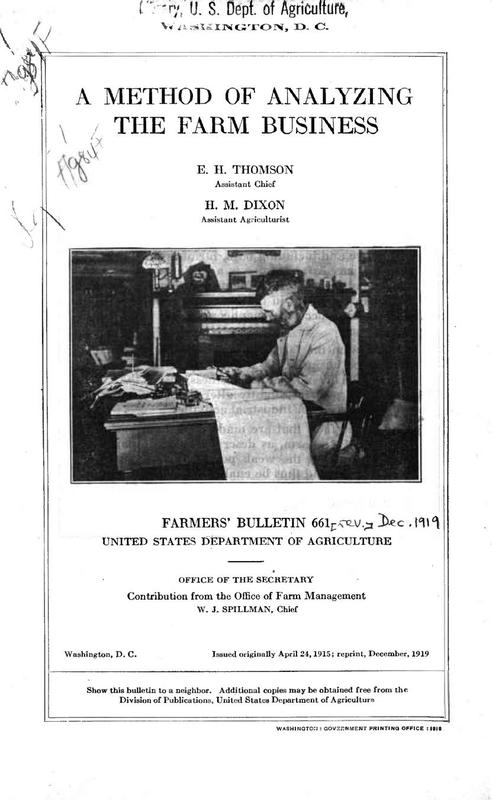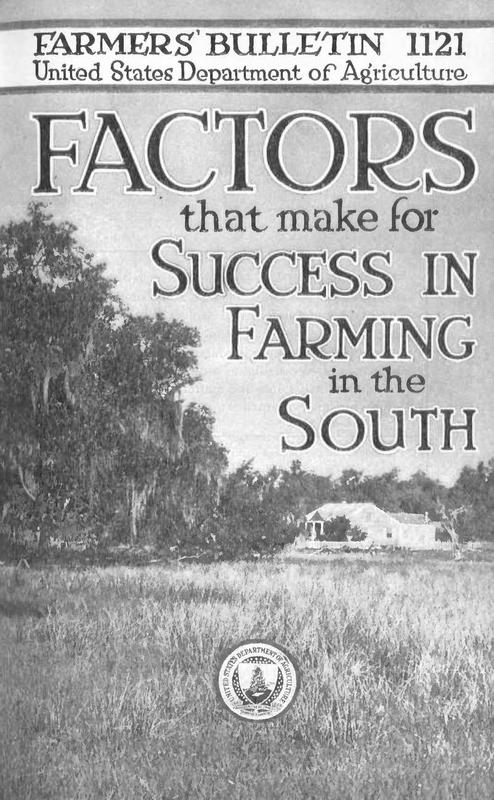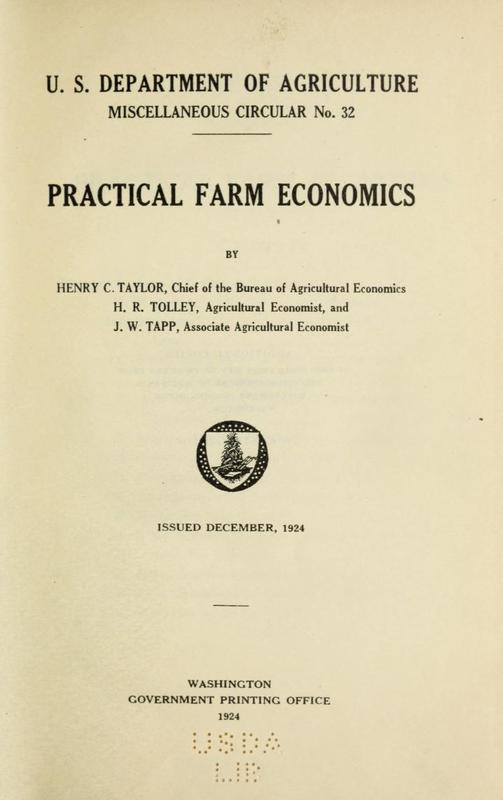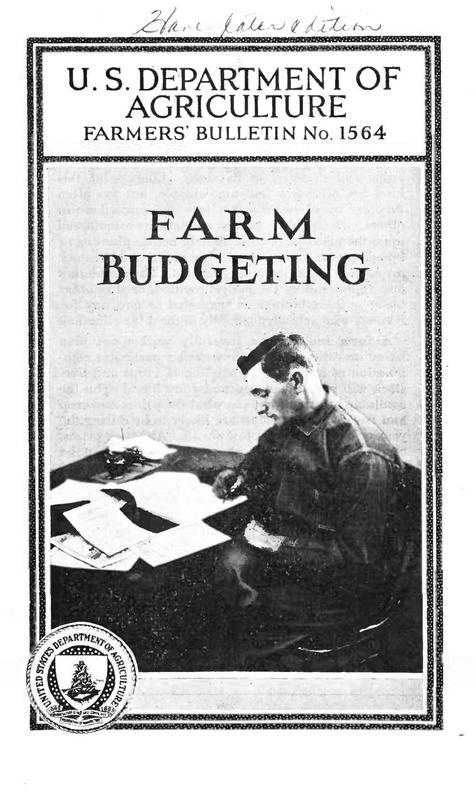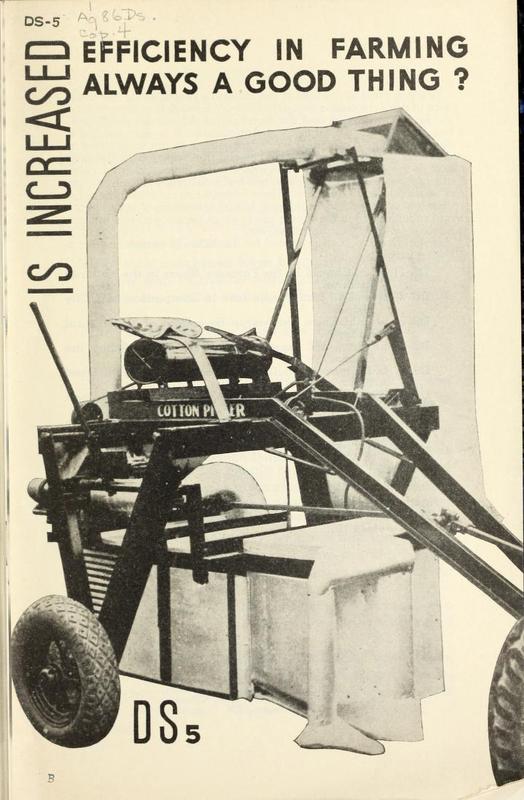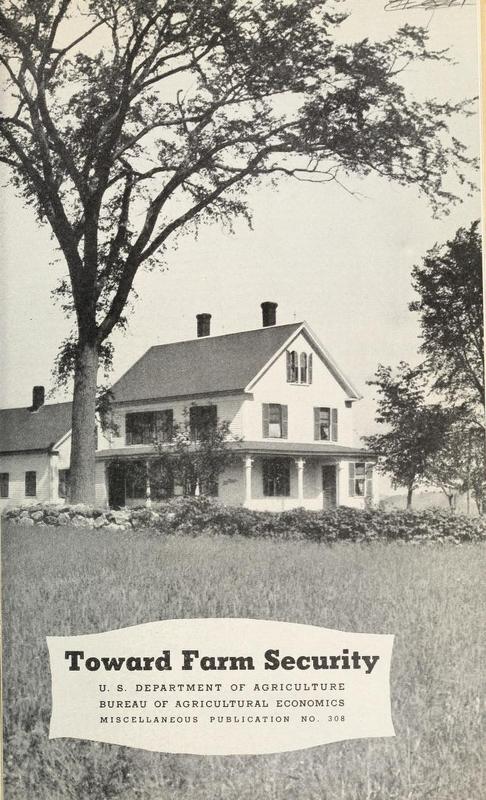Becoming "Thrifty and Self-Supporting"
…[In his bulletins] Carver advocated a way of thinking as much as a set of farm practices. ‘These are only a few of the many ways of becoming thrifty and self-supporting,’ Carver concluded a bulletin entitled How to Make and Save Money on the Farm. ‘Begin at once to put some of them into effect; others I am sure will suggest themselves to you.’ As farmers and housewives became aware of how the creator had arranged the ‘mutual relationship of the animal, mineral and vegetable kingdoms,’ they could not help but recognize ways to make use of materials they had previously discarded or overlooked. ‘The thrifty wide awake farmer will think of many other things to do and ways to do them,’ Carver insisted after giving advice on ‘making the farm comfortable,’ and his wife ‘will readily see…how she can make many delicious and nutritious things not even mentioned’ I his circulars on preserving fruits and vegetables.
This emphasis on learning to think in a different way grew naturally from Carver’s educational philosophy, most especially from his conviction that the study of nature ‘encourages personal investigation, stimulates originality, [and] awakens higher and nobler ideas.’ The lessons he imparted to his students at Tuskegee were the very same ones he tried to teach the farmers of Macon County and the South generally.
Hersey, M.D. (2011). My Work Is That of Conservation: An Environmental Biography of George Washington Carver. Athens, GA: The University of George Press, p. 144.
Carver wrote two bulletins specifically designed to help poor farmers become more efficient, thirfty, and self-supporting. The U.S. Department of Agriculture published many materials on farm management practices at the time of Carver's work at Tuskegee; this section of the exhibit includes a sample of these documents.
(Click any image in this exhibit to get more information, including access to full text)
"It needs but little or no discussion to convince us that we are on the beginning of the most perplexing, most interesting, and the most important period of our lives.
We are confronted with new economic conditions; the problems of last year are not the problems of this year; yea, the problems of yesterday are greatly overshadowed by the problems of today; and even the wisest heads are slow even to conjecture what will be the result, and where coming events will cast their shadows."
"Bulletin No. 39 from the Alabama Experiment Station located at Tuskegee Institute under the direction of Dr. George W. Carver, is being issued at a very opportune time. The problem of farm management is becoming more and more serious every year. It is not that there is any falling off in production; in fact there has been a great increase in production in the last fifteen years. In practically every line America is today producing a surplus crop. The problem of farming, rather than the purely agricultural end, is more and more demanding attention. The farmer must learn how to organize his farm activities, and Bulletin No. 39 contains some sound and valuable information calculated to help the average farmer in this direction.
It will pay to read this bulletin over several times and then study it, and, if necessary, call in the farm demonstration agent for advice and counsel. Both the home demonstration agent and the farm demonstration agent will be glad to assist the farmer and his wife in putting these suggestions into effect.
Every dollar that the farmer saves by producing and conserving what he needs for his own living will be that much gain to him in the sale of his surplus. Dr. Carver is giving instructions that will reduce the amount of cash money that the farmer must spend, so that his cash returns from his crops will be pure gain.
I hope there will be the widest possible circulation given to this bulletin.
R. R. MOTON, Principal
Tuskegee Institute, Alabama,
August 10, 1927"
"Farm management treats of the business of farming from the following standpoints:
(1) Relative desirability of farming and other lines of business.
(2) Selection of the farm.
(3) Organization and equipment of the farm.
(4) Farm operation.
In the brief consideration that can be given the subject here no attempt will be made to treat of these subdivisions exhaustively; nothing further will be attempted than to make clear the nature of the subject, to present an outline of it, and to point out some of the services it can be made to render to the farmer. In the literature of the subject certain parts of farm management have received more adequate treatment than others, and these are presented here in brief outline. Other parts of the subject are newer and have not received adequate treatment in the literature of the subject, for which reason they are treated at greater length in this bulletin.
FARMING AS AN OCCUPATION.
The relative desirability of farming as compared with other occupations is largely a personal matter and must be determined by the circumstances, tastes, and desires of the individual concerned.
Considered from the standpoint of stability, safety, and profitableness there are considerable differences between farming and other lines of business. It is for the most part made up of small inde- pendent units. Farming is, perhaps, more stable and less susceptible to serious interruption from disturbances in the financial world than any other business. On the other hand, it is perhaps more dependent on the elements than any other form of business. In addition, the average profits in farming are small."
"Gulf Coast region upland soils are ordinarily deficient in nitrogen and need to be supplied with liberal quantities of organic matter if profitable crop yields are to be produced. This condition is most easily and cheaply remedied by growing such legumes as velvet beans, cowpeas, soy beans, bur clover, crimson clover, hairy vetch, and beggar weed, and by carefully utilizing all farm manures, crop residues, and other sources of humus. By a simple readjustment most of the cropping systems followed in this region may be made to include one or more legumes which will increase the supply of nitrogen and humus in the soil and greatly increase crop yields. Systems by means of which crop yields are being increased in the region are discussed in the following pages."
"To be successful as a business, a farm should earn a fair rate of interest on the investment and return to the operator fair wages for labor and management after paying all expenses, including depreciation. In the locality under consideration in this bulletin 5 per cent is assumed to be a fair rate of interest on invested capital. It is just about what 68 landlords in this locality averaged from rented farms, and is about what the average reliable real-estate loans would net the investor."
"Farming is an art. It is also a science. But above and including both, farming is a business and the successful farmer is a business man. The basic qualities of a manufacturer, a financier, and a salesman combined in one man are essential to the efficient and successful management of a going farm enterprise.
Success on the farm primarily rests upon (1) the size of the business, (2) the quality of the business, and (3) the diversity of the business, just as the same factors, in perhaps slightly altered forms, underlie any commercial or industrial activities.
With the facts that are made clear by a business analysis of the farm, as described in these pages, a farmer can find the weak points in his system of management and thus be enabled to make those improvements which will produce the financial income needed for success."
"This circular is intended to present a method of testing farms for efficiency in management, with some general standards of efficiency, for the use of farm-management extension workers, county agents, farmers, and others, with special reference to agricultural conditions in the South. The method is by no means exhaustive in character, but it is expected that its use will be helpful.
Many factors influence the success of the farm business, and efficiency maybe tested in numerous ways. Some of the more important tests are here given, such as (1) the production of family and farm supplies, (2) the yield per acre of crops, (3) the production per head of productive live stock, (4) the organization of the crop acreages, (5) the adjustment between labor requirements and labor supply, and (6) secondary tests directly influencing the main factors. These tests should be based on farm surveys, business summaries, and farm-practice records for the communities in which are located the farms considered. A business summary should be prepared for each farm, an average summary for all the farms in the community group, and an average summary for a given number of the best farms in the group.
With these summaries as a basis the farms should be measured individually, applying the tests in the order given, or in such order as circumstances and good judgment may suggest. In the following pages an exposition of these tests is given, with illustrative data and standards. These figures are based on prewar records and conditions, but it is thought that the principles involved will not be changed by war prices and costs."
"The farmer invests capital in land, labor, and equipment for the production of crops, of live stock, and of animal products. It is self-evident that to reach the highest return for time and capital expended he must use his land and equipment, and expend his labor and supplies, with the greatest efficiency and economy possible under his particular climatic, soil, and economic conditions, and according to the information available as to the practices best suited to that environment.
To determine whether he is managing his farm to the best advantage, it is desirable that he not only keep such records as will enable him to make an analysis of his farm business, but also that he compare notes with others to gain knowledge and efficiency from their experience.
These records may range from simple accounts to elaborate systems of bookkeeping, showing receipts, expenses, and inventories for the farm as a whole, or even to complete cost-account records for each individual enterprise on the farm.
The following summary of the business of a Southern farm will give a general idea of the nature of the facts that may be emphasized by keeping farm records."
"In his efforts to make his farm pay, the farmer must decide what to produce and how to produce it and what to sell and how to sell it. His success depends on his making the right decisions on these questions. These questions come up nearly every day in the year and decisions must be based on a knowledge of principles and facts and not on some simple rule of thumb. Farm economics deal with the principles one needs to understand and the information one needs to have in order to make correct decisions. Farmers who understand these principles and know how to apply them are the ones who make the most out of farming."
"The farming industry of the United States loses many hundred millions of dollars each year because production is overexpanded along some lines and underexpanded along others. These ups and downs in agricultural production are partly the result of changes made by farmers in acreages of crops and numbers of livestock. Changes of this kind are necessary and unavoidable, but too often they are overdone in some lines and underdone in others. Decisions as to these changes are often based upon the prices at or immediately before planting or breeding time and upon the crop yields and livestock production of the preceding season. The adaptation and application of the budget method, used in other business undertakings, is suggested as one way for farmers who act independently to meet the situation.
A farm budget is a carefully worked-out plan based on estimates as to how well a particular combination of crops or combination of crops and live- stock will pay. These estimates are based upon the available information as to what the prices and crop and livestock production are likely to be during the year or period of years just ahead. Although prices, crop yields, and livestock production can not be forecast exactly, they can be foretold within broad enough limits to make it profitable to organize care- fully and to focus attention upon the best available information relating to them. A method of doing this is outlined in this bulletin.
First, the method of procedure in making a budget is described. Next, the use of budgets in deciding upon the crops and livestock for the coming year and in keeping a profitable system of farming in mind is described. Finally, the information needed is mentioned, some of the sources of this information are listed, and forms to be used in making a budget are shown."
"The impact of the machine age on farms and cities has been the subject of much discussion. Where do you stand on the following questions?
1. What new machines have been introduced on the farms and in the households of your neighborhood in recent years? What has been their effect?
2. What changes, other than the use of machinery have made farming more scientific in your locality?
3. In your opinion, what is there to be said for the effort to make two blades of grass grow where one grew before? What against?
4. Do you know of cases where the building of new factories or expansion of old ones has made it possible for farm people to get jobs in towns and cities? Do you know of cases where the increased use of machinery in factories has thrown people out of jobs?
5. If the number of city jobs does not increase at the rate it was increasing before the depression, what will become of the children now growing up on the farms?
6. Do you think that the nation should provide a system of social insurance for those who can’t find jobs?
7. How do you think machines might be used to the greater benefit of those who use them? As to efficiency? As to leisure? As to lowered prices for consumers? As to wider distribution of goods?"
"The closer in point of time one is to a period, the less certain he is that any summary judgment is the correct one. And of course, when one attempts to characterize a period that is just beginning he is, to no small degree, engaging in prophecy. He is so close to events that he often cannot correctly see the "shape of things to come." When time has erased many happenings of a period, leaving only the enduring accomplishments, those things that seemed significant at the time have often faded into insignificance.
The period that is just passing and that seems to be gradually evolving into a new period in agricultural affairs has been marked by a struggle to achieve an improved situation for those engaged in farming. Soon after the World War the slogan of the farm groups was "a fair share of the national income." It was pointed out that farmers as a group were receiving a smaller and smaller proportion of the total national income and that ways and means must be found to restore the balance that existed earlier in our history. It was hoped that price improvement would bring about the desired condition, hence the attempts to secure farm-product price advances by means of tariff increases, McNary-Haugen legislation, and the Federal Farm Board. During the latter part of the period "price parity" was the watchword. This was the standard that guided the activities of those administering the original Agricultural Adjustment Act. Later the price-parity concept was changed to "income parity" — another expression of the determination to achieve a more desirable balance between agricultural and nonagricultural enterprises. In recent years much progress has been made toward the goal of better relative prices and incomes for farmers. The situation has not yet improved to a point where it can be said that farmers are on a basis of economic equality with other groups. But it is nearer that point than it has been for years. Possibly the momentum of improvement will continue so that economic balance between agricultural and nonagricultural groups will be reached."
 An official website of the United States government.
An official website of the United States government.



